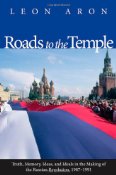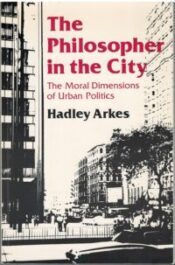
Roads to the Temple: Truth, Memory, Ideas, and Ideals in the Making of the Russian Revolution, 1987-1991 by Leon Aron
 Roads to the Temple:
Roads to the Temple:
Truth, Memory, Ideas, and Ideals in the Making of the Russian Revolution, 1987-1991
by Leon Aron
Roads To The Temple is an exploration of what statism or etatism does to a people, a culture, and a country. Author Leon Aron meticulously examines the historical record leading up to the Russian Revolution of 1987 – 1991 as it relates to the disintegration of the Soviet Union. It is only in the context of the previous seven decades that there can be any possibility of understanding this second Russian Revolution and what its chroniclers were referring to in the things they wrote.
The magnitude of this event is undoubtedly misunderstood by most people outside of Russia. Few Americans can comprehend the enormity of the horrors perpetrated on successive generations of the Russian people. In his study of what was published between 1987 and 1991, Aron gives the reader some sense of the unfathomable. What American can appreciate living under a system where terror is an integral part of governance?
A popular Belarusian writer, Ales Adamovich revealed that in his native village of Glusha every third worker in a small glass-making factory was arrested and never came back: eighty-five in all. A twenty-four year old “loading worker†in a Blogveschensk forestry depot in the Far East was charged with “giving consent to participate in a counter-revolutionary, sabotage organization.â€Â At the trial, which lasted from 2:00 to 2:15 in the afternoon, he was found guilty as charged and sentenced to death. He was shot later the same day. In 1941, an illiterate peasant woman from a tiny Siberian village, a mother of seven by the name of Matryona Chuchalova, was accused of “counter-revolutionary propaganda:†a fellow collective farmer had reported that while weeding millet, Matryona said something about praying openly for the Germans to win (or in Matryona’s version, that there be peace with Germany again). She was sentenced to 6 years in the camps and never heard of again.
Aron recounts dozens and dozens of such individual cases – all thoroughly documented, some by first hand accounts published in the Soviet press during the period of glasnost. However, these individual events were by no means anomalies.
The sociologist Vladimir Shubkin put the number of those executed, or killed by hunger and overwork in the camps during Stalin’s dictatorship (from about 1929 to Stalin’s death in 1953) at 12 million.
Collectivization killed millions more.
In the first Soviet public discussion of the casualties of the collectivization and the famine, leading Party archivists and historians disclosed in Pravda that “no fewer than†481,000 families were sent into a “far exile†in 1930-32; between 400,000 and 450,000 families were left “dispossessed†in their provinces; and 200,000 – 250,000 escaped to cities and factories.  Russian peasant families at the time rarely had fewer than five or six members, and families of ten to twelve were closer to the norm. Indeed, in the ever-changing definitions of the kulaks, which the collectivization was to “liquidate as a class,†larger families were incriminating evidence of wealth and “socially alien†status. Since entire families were punished — to the last man, boy, girl, pregnant woman, infant, infirm grandmother, the paralyzed, and the mentally ill — the total of 1,081,000 families from these estimates should be multiplied accordingly. By [historian] Medvedev’s count, there were at least 10 million victims.  This was also the number Stalin mentioned to Churchill in Moscow in August 1942 as the peasants he, Stalin, had to “struggle with.â€
These horrors were not unintentional. Nor were they all that was inflicted on the Russian people. There was also the artificial famine purposely created to help “liquidate†the kulak class.
But it wasn’t just the kulaks and the millions sent to the camps, doomed to starvation or execution, which suffered under the Soviet regime. The vast majority of the populace endured crushing poverty, endless shortages, horrendous medical care, and squalid, cramped housing. These were the fruits of a system structured to produce these results. It is impossible to recount all of the examples Aron covers in his book, so instead this review will focus on the conclusions drawn by the people themselves during and shortly after Gorbachev’s perestroika.
The most surprising thing (for this reviewer) was the conclusion by Gorbachev and his cadre that the problem with the Soviet state was one of morality. In the words of Gorbachev’s first Prime Minister,
[By 1985] the stuffiness of the country has reached maximum: after that only death. Nothing was done with any care … [We] stole from ourselves, took and gave bribes, lied in the reports, in the newspapers, from high podiums, wallowed in our lies, hung medals on one another. And all of this — from top to bottom and bottom to top.
Foreign Minister Edvard Shevardnadze recalls telling Gorbachev in the winter of 1984-5 “Everything is rotten, it has to be changed.â€
Years after he was deposed, Gorbachev said in an interview:
The Soviet model was defeated not only on the economic and social levels; it was defeated on a cultural level. Our society, our people, the most educated, the most intellectual, rejected that model on the cultural level because it does not respect the man, oppresses him spiritually and politically … That is why the most important for us [was] everything connected with freedom.
But another of Gorbachev’s ministers was even more blunt. Alexander Yakovlev took charge of the “ideology†in 1985. According Yakovlev the “reformation†of this period (1985-1991) was a spiritual transformation, an “attempt to … end the amorality of the regime.â€
Remember, these men were not particularly religious. In fact the Soviet state was officially atheist. Yet they, and countless others, identified the biggest problem in the country as a moral one.
The key is the reordering of the system of spiritual and moral values, the understanding of what man lives for, of what his calling is. Today, the entire economic development of the country is up against the moral essence of man. Nothing can be changed significantly for the better in the economy if we ourselves do not change for the better. — Mikhail Antonov, Oktyabr Magazine, August 1987.
One can comprehend how the privileged might talk about losing their moral compass, or perhaps even stand on their soapboxes and castigate the masses for their (state-sponsored) alcoholism, low productivity, etc. However, this was different. Instead it was an acknowledgement of what the state had done to its people. The state did what it set out to do, create a new Soviet man – homo sovieticus.
In a chapter entitled – “The Disintegration of Souls,†– Aron provides numerous examples of the great social/psychological experiment gone awry, that was the Soviet Union. In an article entitled “A Witness†in Znamya, Alexander Shindel summarized the effect of etatism on the psyche of the people:
For decades the state has conducted a most immoral internal policy — a policy of deception and violence. Today it is a people that are bearers of this immorality. There are many of them but they are a consequence of the many years of the immoral totalitarian state. It was cruel, and they have become cruel. It recognized only the cult of brute force and was unscrupulous in the means of dealing with its own citizens — and they also have become unscrupulous.
The new Soviet Man didn’t turn out as the propaganda promised.
Homo Sovieticus was envious of his neighbor who managed to earn more: “better that my cow dies than that my neighbor has two.â€Â The squalor of the Soviet village, concluded a leading economic essayist, was “retribution†for over five decades of “violating common sense, violating everything that urges man to a normal, conscientious labor.â€
Additional traits inculcated into the new Soviet Man were:
- Compulsive thievery from the state (it was considered rightful or righteous to steal from the state)
- Deceit, repeatedly breaking laws by fudging reports, doctoring records or working on the side on other jobs than that paid for.
- Hatred of work, any work. Conscientious labor looked at as shameful or foolish.
Aron adds,
Homo Sovieticus was a net destroyer of value, “making bad things from good materials, and turning worthy into worthless.â€Â A sovhoz [collective farm – note WWTFT] milkmaid refused to feed her hungry cows, who were lowing loudly: “I am paid 370 rubles to get to the farm and milk,†she explained. “And that is enough for me. To add feeding to this — well, why should I?â€
Although not featured in the book, this reviewer remembers another common Russian expression. “They pretend to pay us, and we pretend to work.â€
The lack of dignity due to the continuous suppression of the individual crushed the people’s character.
This crushing of the individual, intentionally perpetrated by an all-powerful state, is what Hayek and Mises wrote about in The Road to Serfdom, and Bureaucracy, respectively. But there are other themes as well. Roads to The Temple provides demonstrable and irrefutable real world proofs of the existence of evil. Many of the events recounted in this book could have formed chapters in Orwell’s 1984. In his Rules for Radicals, Saul Alinsky explains how the ends always justify the means. His words are reminiscent of Lenin’s famous metaphor of eggs and omelets. Alinsky (had he not been a Jew) would have been quite at home in Stalin’s Russia.
While Alinsky may have been comfortable (ethnicity issues notwithstanding) in the Russia of Stalin’s time, he would also relate to the social policies of current thug – Putin.   The second Russian Revolution died and Stalin is being rehabilitated by official policy. Aron explains that Stalin was just one man, a horrible man to be sure, but the product of the state. He even postulates that Stalinism would have existed with or without Stalin. It is the state and “etatism†itself that is fundamentally flawed. Five brief years was not going to remove the established powers, nor undo the consequences of 70+ years of character warping repression.
It is not clear what the future holds for Russia and Aron does not prognosticate. Roads to the Temple is an important book. It provides a blueprint of what not to do to a society. Anyone who reads this book will understand why socialism/communism should be stigmatized and regarded as profanity.
 The posts are coming!
The posts are coming!

2 comments
Aside from the obvious, the thing that strikes me most is how like employment in the US federal government the soviet conditions were – deceit, thievery, and a hatred of work resulting from a crushing of the human spirit. Certainly this does not exist among all federal employees, but is most obvious among employees of unconstitutional agencies.
[Reply]
martin Reply:
August 23rd, 2012 at 8:44 am
One of the similarities that I saw in the book was the behavior of union thugs in the US to workers in state run plants in the USSR. State workers in the USSR were distrustful of anyone who tried to show pride in their work or do a good job. They viewed it as a threat and a risk that they too might be expected to work harder – for no extra pay. They prided themselves on doing as little as possible and viewed anyone else as foolish. In their situation, this may have been prudent, but it doesn’t make for a successful society. Some Unions show the same behaviors – and try to prevent anyone from leaving the union so as to enforce mediocrity.
[Reply]
Leave a Comment